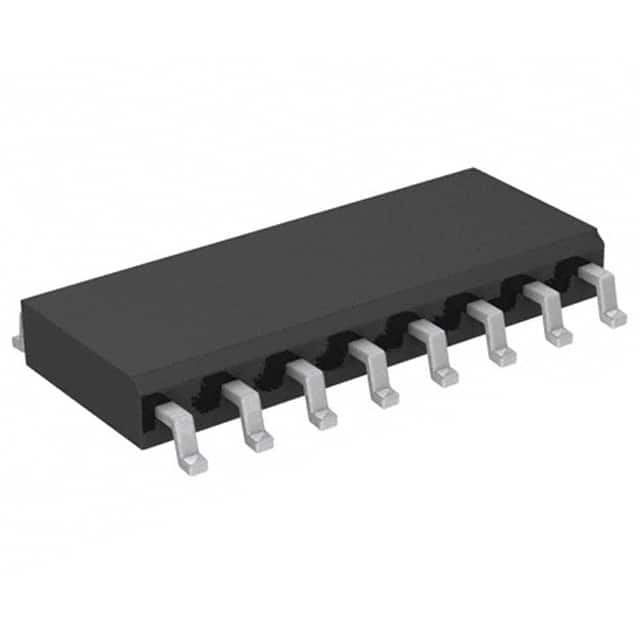Viz Specifikace pro podrobnosti o produktu.

M74HC4051RM13TR
Product Overview
- Category: Integrated Circuit (IC)
- Use: Multiplexer/Demultiplexer
- Characteristics: High-speed CMOS logic, 8-channel analog multiplexer/demultiplexer
- Package: SO-16
- Essence: The M74HC4051RM13TR is a versatile IC that allows for the selection of one of eight analog signals or digital inputs to be routed to a single output line.
- Packaging/Quantity: Available in tape and reel packaging with 2500 units per reel.
Specifications
- Supply Voltage: 2V to 6V
- Operating Temperature Range: -40°C to +125°C
- Input Voltage Range: 0V to Vcc
- On-state Resistance: 80Ω (typical) at Vcc = 4.5V
- Channel Leakage Current: ±10nA (maximum) at Vcc = 6V
- Propagation Delay Time: 15ns (typical) at Vcc = 4.5V
- Power Dissipation: 500mW (maximum)
Detailed Pin Configuration
The M74HC4051RM13TR has a total of 16 pins arranged as follows:
___________
| |
1 | A0 | 16
2 | A1 | 15
3 | A2 | 14
4 | E | 13
5 | Y | 12
6 | Z | 11
7 | B0 | 10
8 | B1 | 9
|___________|
Functional Features
- 8-channel analog multiplexer/demultiplexer
- Wide operating voltage range
- Low power consumption
- High-speed CMOS logic
- Break-before-make switching action
- ESD protection (HBM > 2kV)
Advantages and Disadvantages
Advantages: - Versatile IC suitable for various applications - Wide operating voltage range allows compatibility with different systems - Low power consumption helps in energy-efficient designs - High-speed CMOS logic enables fast signal processing - ESD protection ensures robustness against electrostatic discharge
Disadvantages: - Limited to 8 channels, may not be suitable for applications requiring more inputs/outputs - Propagation delay time may affect real-time applications with strict timing requirements
Working Principles
The M74HC4051RM13TR operates as a multiplexer or demultiplexer by controlling the selection of one input channel among eight possible options. The control pins A0, A1, and A2 are used to set the desired channel, while the enable pin (E) activates the IC. The selected input is then routed to the output pin (Y). The Z pin is used for additional demultiplexing functionality.
Detailed Application Field Plans
The M74HC4051RM13TR finds applications in various fields, including:
- Audio and Video Switching Systems: Used to select different audio/video sources for routing to a single output.
- Data Acquisition Systems: Enables the selection of multiple analog signals for measurement and processing.
- Communication Systems: Facilitates the switching between different communication channels.
- Industrial Control Systems: Allows for the selection of various sensor inputs for monitoring and control purposes.
- Test and Measurement Equipment: Used to route different test signals to a common measurement device.
Detailed and Complete Alternative Models
- CD4051B: Similar 8-channel analog multiplexer/demultiplexer IC from Texas Instruments.
- 74HC4051: High-speed CMOS logic multiplexer/demultiplexer from NXP Semiconductors.
- DG408: Precision CMOS analog multiplexer/demultiplexer from Maxim Integrated.
These alternative models offer similar functionality and can be considered as substitutes for the M74HC4051RM13TR based on specific requirements and availability.
Word count: 525 words
Seznam 10 běžných otázek a odpovědí souvisejících s aplikací M74HC4051RM13TR v technických řešeních
Sure! Here are 10 common questions and answers related to the application of M74HC4051RM13TR in technical solutions:
Q1: What is the M74HC4051RM13TR? A1: The M74HC4051RM13TR is a high-speed CMOS analog multiplexer/demultiplexer integrated circuit.
Q2: What is the purpose of the M74HC4051RM13TR? A2: The M74HC4051RM13TR is used to select one of eight analog signals or digital inputs and route it to a single output.
Q3: What voltage levels does the M74HC4051RM13TR support? A3: The M74HC4051RM13TR supports voltage levels from 2V to 10V.
Q4: How many channels does the M74HC4051RM13TR have? A4: The M74HC4051RM13TR has 8 channels, allowing for selection between 8 different inputs.
Q5: Can the M74HC4051RM13TR be used as a demultiplexer? A5: Yes, the M74HC4051RM13TR can be used as both a multiplexer and a demultiplexer.
Q6: What is the maximum frequency at which the M74HC4051RM13TR can operate? A6: The M74HC4051RM13TR can operate at a maximum frequency of 50 MHz.
Q7: Does the M74HC4051RM13TR require external power supply? A7: Yes, the M74HC4051RM13TR requires an external power supply with a voltage range of 2V to 10V.
Q8: Can the M74HC4051RM13TR handle both analog and digital signals? A8: Yes, the M74HC4051RM13TR can handle both analog and digital signals.
Q9: What is the typical on-resistance of the M74HC4051RM13TR? A9: The typical on-resistance of the M74HC4051RM13TR is around 80 ohms.
Q10: Can the M74HC4051RM13TR be cascaded to increase the number of channels? A10: Yes, multiple M74HC4051RM13TR ICs can be cascaded together to increase the number of channels for selection.
Please note that these answers are general and may vary depending on the specific application and requirements.

